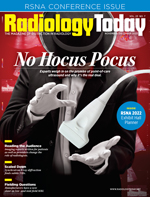 CT Slice: Contrasting Styles
CT Slice: Contrasting Styles
By Beth W. Orenstein
Radiology Today
Vol. 23 No. 7 P. 42
Plan for future contrast shortages with these steps.
The COVID-19 related shutdown of a GE Healthcare plant in Shanghai, China, earlier this year interrupted the manufacturing of iodinate contrast media used in many imaging exams. Many health care providers, especially those with exclusively GE imaging equipment, had to delay elective contrast enhanced CT exams; convert exams to noncontrast exams, if possible; and reduce the dose of contrast media where possible. In still other situations, physicians had to substitute other types of exams, such as MRI, ultrasound, or noncontrast PET/CT.
The steps that were taken to offset the shortage “were OK for a limited time, but not something anyone would want to do forever,” says Thomas Grist, MD, chair of the department of radiology at the University of Wisconsin School of Medicine and Public Health in Madison.
So, what should the radiology community do to minimize the impact should there be another shock to the supply of contrast media in the future? Grist offers the following suggestions for conserving contrast:
• Weight-based dosing. “We do it at the University of Wisconsin, but weight based dosing varies across the country, and many don’t do it,” Grist says. Studies have shown that weight-based contrast dosing optimizes enhancement when compared with fixed-volume techniques. One study, published in 2011 in Clinical Radiology, found that using a simple, practical, weight-based look-up table to decide contrast media volumes greatly reduced interpatient variability in portal phase CT liver exams. Another study, published in 2018 in Radiography, found that weight adapted contrast regimes could not only reduce contrast dose in abdominopelvic CT but also result in cost savings as well.
• Repackage single-dose vials. Many pharmacies are reluctant to repackage single-dose vials because the CDC advises against the practice, Grist says. The CDC is opposed to the practice because the vials typically lack antimicrobial preservatives and can become contaminated, serving as a source of infection when used improperly. Several instances of iatrogenic infection have been reported with improper use of single-use vials for multiple patients when basic infection control techniques were violated. Some of these events occurred during times of medication shortages, as efforts to reduce waste, according to the ACR.
However, Grist says it is possible to develop procedures so that the vials could be safely used for more than one patient, significantly reducing waste. Grist believes the CDC, the FDA, and the companies that make tubing, needles, syringes, and syringe injectors—the entire supply chain—could look at this issue and find acceptable procedures to make the use of multiple doses from the same vial safe and help eliminate waste at the same time.
In May 2012, in response to medication shortages, the CDC reiterated its position that medications labeled as “single-dose” or “single-use” should be used for only one patient. However, it said, in times of critical need, contents from unopened single-dose/single-use vials could be repackaged for multiple patients. If vials were repackaged, it should be done only by qualified health care personnel in accordance with standards in the US Pharmacopeia General Chapter 797 on Pharmaceutical Compounding – Sterile Preparations.
At the time, the American Society of Health System Pharmacies also offered guidance for the safe use of single-use vials for more than one patient. It recommends that institutions explore developing their own guidelines for the safe use of single-use vials for more than one patient, following proper infection control guidance and ensuring institution approval, since it would deviate from medication and regulatory guidelines.
ACR Recommendations
The ACR also suggested the following steps for providers faced with contrast shortages:
• Utilize alternative studies to answer the clinical question, such as noncontrast CT, MR with or without gadolinium-based contrast media, ultrasound with or without ultrasound contrast agents, nuclear medicine, or PET/CT, when feasible. Refer to the ACR Appropriateness Criteria guidelines for indicated alternative studies, as needed. Scroll down to AC Portal and use the “Explore by scenario” icon.
• Look for alternative versions of contrast agents, which may be marketed under different brand names or intended clinical uses. Note: US market availability may differ from global availability.
• Source contrast from other vendors, if able, and consider having at least two vendor products on formulary.
• Reserve higher concentration (mg iodine/ml) agents for angiographic studies and multiphase studies, which require optimal vascular visualization.
• Use alternatives to nonionic contrast for oral, rectal, or genitourinary administration, eg, iothalamate meglumine or diatrizoate. Consider barium-based products for oral opacification in CT and PET/CT, as well as alternative iodine-based agents (ionics). Refer to the ACR Contrast Manual APPENDIX A: Contrast Media Specifications Table for oral contrast agents.
• Work with other departments, such as urology, radiation oncology, pain management, gastroenterology, vascular surgery, and cardiology, that utilize iodinated contrast to prioritize limited supply usage.
In any case, Grist and the ACR say, never sacrifice image quality by using suboptimal doses. Always ensure enough contrast dose is used for diagnostic image quality.

